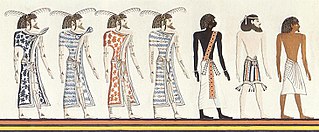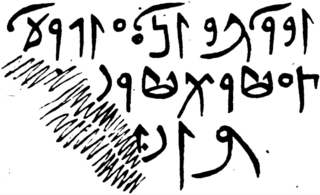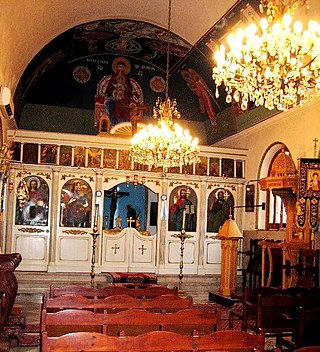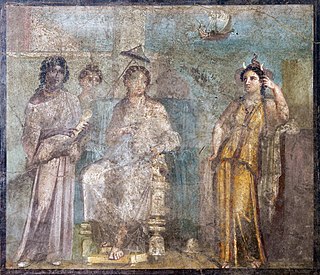Related Research Articles

Tifinagh is a script used to write the Berber languages. Tifinagh is descended from the ancient Libyco-Berber alphabet. The traditional Tifinagh, sometimes called Tuareg Tifinagh, is still favored by the Tuareg people of the Sahara desert in southern Algeria, northeastern Mali, northern Niger, and northern Burkina Faso for writing the Tuareg languages. Neo-Tifinagh is an alphabet developed by the Berber Academy by adopting Tuareg Tifinagh for use for Kabyle; it has been since modified for use across North Africa.

Berbers, or the Berber peoples, also known as Amazigh or Imazighen, are a diverse grouping of distinct ethnic groups indigenous to North Africa who predate the arrival of Arabs in the Maghreb. Their main connections are identified by their usage of Berber languages, most of them mutually unintelligible, which are part of the Afroasiatic language family.

Cyrenaica or Kyrenaika, is the eastern region of Libya. Cyrenaica includes all of the eastern part of Libya between the 16th and 25th meridians east, including the Kufra District. The coastal region, also known as Pentapolis in antiquity, was part of the Roman province of Crete and Cyrenaica, later divided into Libya Pentapolis and Libya Sicca. During the Islamic period, the area came to be known as Barqa, after the city of Barca.

Moses the Black, also known as Moses the Strong, Moses the Robber, and Moses the Ethiopian, was an ascetic hieromonk in Egypt in the fourth century AD, and a Desert Father. He is highly venerated in the Eastern Orthodox Church and the Oriental Orthodox Church. According to stories about him, he converted from a life of crime to one of asceticism. He is mentioned in Sozomen's Ecclesiastical History, written about 70 years after Moses's death.
The Meshwesh was an ancient Libyan tribe, of Berber origin along with other groups like Libu and Tehenu/Tjemehu, and also some of the Sea Peoples.
Samuel the Confessor is a Coptic Orthodox saint, venerated in all Oriental Orthodox Churches. He is most famous for his torture at the hands of the Chalcedonian Byzantines, for his witness of the Arab invasion of Egypt, and for having built the monastery that carries his name in Mount Qalamoun. He carries the label "confessor" because he endured torture for his Christian faith, but was not a martyr.

The Blemmyes were an Eastern Desert people who appeared in written sources from the 7th century BC until the 8th century AD. By the late 4th century, they had occupied Lower Nubia and established a kingdom. From inscriptions in the temple of Isis at Philae, a considerable amount is known about the structure of the Blemmyan state.

During the Iron Age and Classical antiquity, Libya referred to the area of North Africa directly west of the Nile river, not to be confused with modern country Libya which only represents the eastern part of the territory at the time. Ancient Libya was one of the three parts of the world of the ancients the territory also had part of the Mediterranean Sea named after it called the Libyan Sea or Mare Libycum which was the part of the Mediterranean south of Crete, between Cyrene and Alexandria.
The traditional Berber religion is the sum of ancient and native set of beliefs and deities adhered to by the Berbers. Originally, the Berbers seem to have believed in worship of the sun and moon, animism and in the afterlife, but interactions with the Phoenicians, Greeks and Romans influenced religious practice and melted traditional faiths with new ones.

The Libu were an Ancient Libyan tribe of Berber origin, from which the name Libya derives.

Wadi El Natrun is a depression in northern Egypt that is located 23 m (75 ft) below sea level and 38 m (125 ft) below the Nile River level. The valley contains several alkaline lakes, natron-rich salt deposits, salt marshes and freshwater marshes.

The Monastery of Saint Macarius The Great also known as Dayr Al-ʾanbā Maqār is a Coptic Orthodox monastery located in Wadi El Natrun, Beheira Governorate, about 92 km (57 mi) north-west of Cairo, and off the highway between Cairo and Alexandria.

The area of North Africa which has been known as Libya since 1911 was under Roman domination between 146 BC and 672 AD. The Latin name Libya at the time referred to the continent of Africa in general. What is now coastal Libya was known as Tripolitania and Pentapolis, divided between the Africa province in the west, and Crete and Cyrenaica in the east. In 296 AD, the Emperor Diocletian separated the administration of Crete from Cyrenaica and in the latter formed the new provinces of "Upper Libya" and "Lower Libya", using the term Libya as a political state for the first time in history.

Human habitation in the North African region began over one million years ago. Remains of Homo erectus during the Middle Pleistocene period, has been found in North Africa. The Berbers, who generally antedate by many millennia the Phoenicians and the establishment of Carthage, are understood to have arisen out of social events shaped by the confluence of several earlier peoples, i.e., the Capsian culture, events which eventually constituted their ethnogenesis. Thereafter Berbers lived as an independent people in North Africa, including the Tunisian region.
The Laguatan was a Berber clan that inhabited the Cyrenaica area during the Roman period. They have been described as primarily raiders and nomadic as their ancestors the Nasamones, but others consider them a settled group who also raided.

Gurzil was an important ancient Berber deity. He is known from two sources, the Latin poem Iohannis by the 6th-century Christian Roman poet Corippus and a Neo-Punic inscription from Lepcis Magna.

Copts in Libya may refer to people born in or residing in Libya of full or partial Coptic origin. Coptic people are an ethnoreligious group that form the largest Christian group in Libya, the Coptic Orthodox Church in the country having an estimated 60,000 adherents. The Coptic Church is known to have historical roots in Libya long before the Arabs advanced westward from Egypt into Libya. A part of the community is made up of immigrants from Egypt.

The Goddess Africa, in Latin Dea Africa, was the personification of Africa by the Romans in the early centuries of the common era. She was one of the fertility and abundance deities in North Africa worshiped by the tribe of Ifri. Her iconography typically included an elephant-mask head dress, a cornucopia, a military standard, and a lion.

The Forty-Nine Martyrs of Scetis were Christian monks of the monasteries of Scetis in Roman Egypt who were massacred by Berbers during a raid in 444. Two laymen were martyred along with them. Their relics lie in the Monastery of Saint Macarius the Great. They are venerated in the Coptic Orthodox Church, but not in the Eastern Orthodox or Roman Catholic churches.
The Austuriani or Austoriani were a Berber people who lived along the frontier of the Roman Empire in Africa in the desert region south of the Gaetulii in the border of modern day Algeria and Libya. They appear as raiders and enemies of the Romans from Roman sources between the fourth and sixth centuries. These polytheistic nomads worshipped Agurzil, the bull-god of war, emblem of the Laguatans, "son of the god Ammon and a fierce heifer". He was worshipped by all the berber peoples of Libya. Ghirza seems to be his main place of worship.
References
- 1 2 Salem Chaker (1986), "Amaziɣ (le/un Berbère)", Encyclopédie berbère , 4, pp. 562–568, retrieved 25 January 2020.
- ↑ Anthony Leahy (2001), "Libya", in Donald B. Redford (ed.), The Oxford Encyclopedia of Ancient Egypt (Oxford University Press), retrieved 25 January 2020.
- ↑ Paolo Asso (2010), A Commentary on Lucan, "De bello civili" IV: Introduction, Edition, and Translation (De Gruyter), pp. 258–259.
- 1 2 3 Oric Bates, The Eastern Libyans: An Essay (Macmillan, 1914), pp. 237–238.
- ↑ Tim Vivian, "The Coptic Orthodox Church", in Gawdat Gabra (ed.), Coptic Monasteries:Egypt’s Monastic Art And Architecture (American University in Cairo Press, 2002), pp. 14–15.
- ↑ William Dalrymple (2005), From the Holy Mountain (Harper Perennial), pp. 413–414.